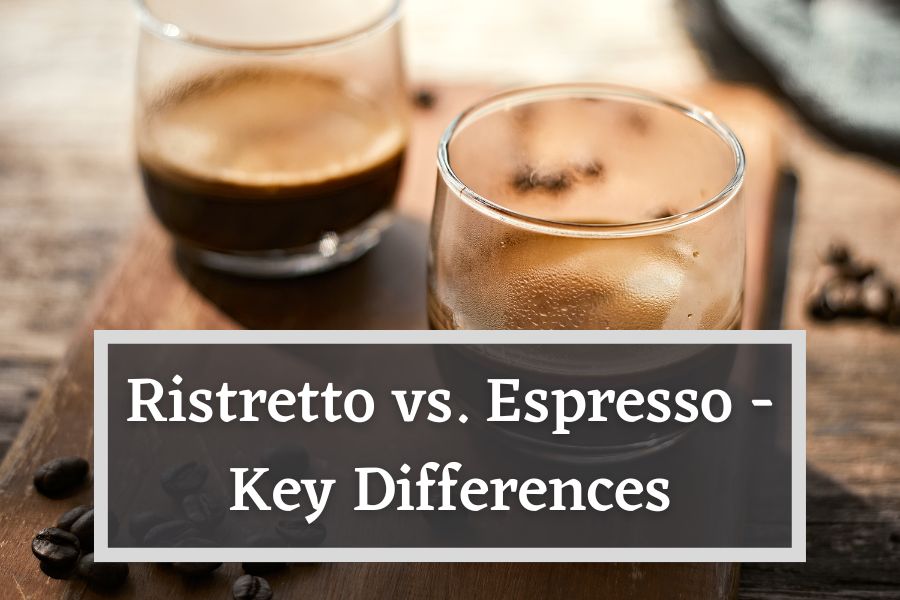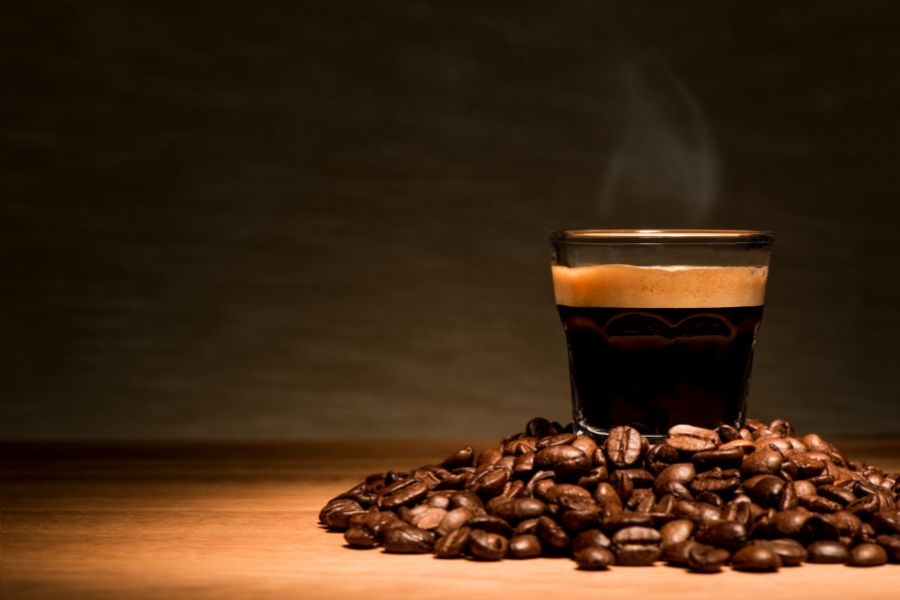If you’ve ever enjoyed a cup of coffee, chances are you have heard of espresso and ristretto. Both types of coffee have become popular due to their strong flavour profiles, but if you don’t know what the differences are between them it can be confusing.
It doesn’t help that some people use the terms interchangeably, either!
The difference between ristretto and espresso lies in the amount of water used to prepare the shot. Espresso shots are extracted using a relatively larger volume of water, while ristretto shots are prepared with a smaller amount of water.
As for me: ristretto vs. espresso, I prefer the former due to its size and kick! But before you decide for yourself, let’s go over the basics and other key differences.

Espresso Basics
Espresso is a bold and intense coffee beverage that is brewed by forcing hot water through finely-ground coffee beans.
The brewing process is achieved through the use of an espresso machine, which applies pressure to the coffee grounds as hot water is slowly filtered through them. This creates a highly concentrated and flavorful shot of coffee.
Espresso originated in Italy and is widely considered to be a hallmark of Italian coffee culture. In fact, the word “espresso” is derived from the Italian phrase “caffè espresso,” which translates to “pressed coffee.”

Espresso is traditionally served in small demitasse cups and is meant to be savoured slowly, often while standing at a café bar in Italy. Learn how to drink espresso.
Espresso is known for its rich and bold flavour profile, which is characterized by its heavy body, strong taste, and powerful aroma. This is due to the high concentration of coffee oils and solids that are present in the beverage, as well as the unique brewing method that extracts more flavour from the coffee beans than other brewing techniques.
Ristretto Basics
Ristretto is a type of espresso coffee that has gained immense popularity over the years, particularly in Italy. How it is made, you ask?
It is made with the same pressure and method as a regular espresso shot, but with half the amount of water, which results in a more concentrated and flavorful cup of coffee.
The word “ristretto” comes from the Italian word “restricted,” which accurately describes the limited amount of water that is used in making it.

Typically, a standard shot of espresso takes about 30 seconds to brew, with a volume of around 30 millilitres. Ristretto, on the other hand, takes only around 20-25 seconds to brew, producing only 15-20 millilitres of coffee.
One of the main benefits of drinking ristretto is its intense flavour profile. Because of the limited amount of water used, the coffee’s flavour is not diluted, resulting in a strong and robust taste.
Furthermore, ristretto is known to contain more caffeine per unit of volume than a regular espresso shot. This is because the flavour compounds and oils present in the coffee bean dissolve more slowly in the limited amount of water, resulting in a higher concentration of caffeine in the final product.
Ristretto vs. Espresso – Key Difference
Overall, the main difference between espresso and ristretto lies in the amount of water used to prepare the shots. Whereas espresso shots are brewed with a larger volume of water and yield a full-bodied flavour profile, ristretto shots are brewed with less water and produce a sweeter and more concentrated flavour.
Here’s a list of differences between them:
| Espresso | Ristretto | |
| Water content | 1oz (30ml) | 0.7oz (20ml) |
| Flavour profile | Blod/rich/bitter | Sweet/less bitter |
| Caffeine content | 68mg | 63mg |
| Serving size | 1-2oz cup | 0.5-1oz cup |
| Popular pairings | Milk | Nothing |
| Brewing equipment | Espresso machine | Espresso machine |
- Water content: Espresso is brewed by forcing highly pressurized hot water through finely ground coffee beans for around 20-30 seconds. Whereas, ristretto uses the same method, but with less water, resulting in a shorter and more concentrated shot.
- Flavour profile: Espresso, also known as a “short black”, has a bold, rich flavour with a slight bitterness and a crema on top. Ristretto, on the other hand, has a sweeter, more intense flavour profile. It is also less bitter and less acidic in taste.
- Caffeine content: Due to the shorter brewing time and less water used, ristretto has a higher concentration of caffeine than espresso. This makes it an ideal choice for those who want a more potent caffeine kick.
- Serving size: Espresso is typically served in a small 1-2 oz cup, while the ristretto shot is usually even smaller, with only 0.5-1 oz of coffee in each shot.
- Popular pairings: Espresso is often paired with steamed milk to create drinks like cappuccino, latte, or Americano. Ristretto, on the other hand, is usually served as a stand-alone shot in a smaller cup or mug.
- Brewing equipment: Both espresso and ristretto require a specialized coffee machine known as an espresso machine. The machines vary in complexity and price, with simpler machines being suitable for home use and more complex ones used at coffee shops and cafes.
Conclusion
We have now explored the differences between these two types of espresso drinks. So which is better, ristretto vs. espresso? Which one should you choose?
Espresso is a renowned classic brew which is favoured by those who appreciate the fragrant aroma and vigorous flavour found in traditional Italian-style espresso.
At the same time, ristretto’s full-bodied finish and robust texture make it ideal for those who are looking to intensify or invigorate their daily cup of coffee.
But regardless of whether you’re leaning towards the faster extraction time offered by ristretto, or prefer the more down-to-earth appeal that espresso has to offer – one thing remains clear: both will provide you with an entirely unique cafe experience that no other drink can replicate!
Enjoy your espresso or ristretto!
Interested in learning more about how espresso compares to other drinks? Here is a detail guide about differences between lungo and espresso.
FAQs
What is the optimal water temperature for making espresso and ristretto?
The optimal water temperature for making espresso and ristretto is between 195-205°F (90-96°C).
Can the amount of crema differ between espresso and ristretto?
Yes, the amount of crema (the foam layer on top of espresso) can differ between espresso and ristretto due to the difference in the amount of water used. Ristretto typically has less crema than espresso.
Can the caffeine content differ between espresso and ristretto?
The caffeine content in espresso and ristretto can differ due to the amount of water used. Ristretto has more caffeine because it is more concentrated, resulting in a stronger caffeine hit per ounce.
